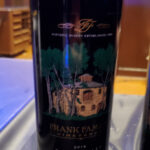USA:
The Country and its Wine
 The United States of America is regularly the #4 producer of wine in the world, and the #1 consumer of wine in the world.
The United States of America is regularly the #4 producer of wine in the world, and the #1 consumer of wine in the world.
The US wine industry contributes over $220 billion to the American economy every year. It provides about a million jobs and helps a significant wine tourism industry of 27 million people visiting wineries each year. The US exports about $1.5 billion in wine every year.
The USA features diverse soils for winemaking. California has volcanic, sandy, loamy, and gravelly soils, with regions like Napa having well-drained volcanic soils ideal for Cabernet Sauvignons. Sonoma benefits from clay loam, while coastal areas favor sandier soils for aromatic wines. A massive amount of microclimates across the entire country allow for a huge diversity in grape cultivation. Cold-weather hardy hybrids are becoming more popular in the midwest.
When you think of American wine, you probably only think about California, but did you know there’s a lot more?
🌐American Wine Regions
🗺️ California
 California produces around 85% of all American wine. It’s no secret that most of the modern perception of American wine comes from California’s regions, like:
California produces around 85% of all American wine. It’s no secret that most of the modern perception of American wine comes from California’s regions, like:
- Napa Valley is California’s most renowned wine region, celebrated for its world-class Cabernet Sauvignon and iconic wineries.
- Sonoma County is known for its diverse microclimates, producing exceptional Pinot Noir, Chardonnay, and Zinfandel.
- The Central Coast spans from San Francisco to Santa Barbara, offering cool-climate Syrah, Pinot Noir, and Chardonnay.
- Paso Robles is a dynamic region famous for robust red blends and bold Rhône varietals.
- Santa Barbara County features cool coastal vineyards ideal for Pinot Noir and Chardonnay, with warmer areas excelling in Syrah.
- Mendocino County produces organic and biodynamic wines, with a focus on Pinot Noir and white varietals like Gewürztraminer.
- Lodi is a historic region recognized for old-vine Zinfandel and a growing variety of innovative wines.
- The Sierra Foothills feature high-altitude vineyards producing bold Zinfandel, Barbera, and Rhône varietals.
- Monterey County is cooled by ocean breezes, making it a hub for elegant Pinot Noir and Chardonnay.
- Livermore Valley is one of California’s oldest wine regions, known for Petite Sirah and Sauvignon Blanc.
🗺️ Other Notable Winemaking States
 Washington State is the second-largest wine producing state in the US, known for Cabernet Sauvignon, Merlot, and Syrah.
Washington State is the second-largest wine producing state in the US, known for Cabernet Sauvignon, Merlot, and Syrah.
- The Columbia Valley AVA dominates Washington’s production with a wide variety of styles.
- Walla Walla Valley is known for robust and structured Syrah and Cabernet Sauvignon.
- Yakima Valley features great white wines, and is home to many of the state’s oldest vineyards.
- Red Mountain produces some of the state’s most powerful, age-worthy Cabernet Sauvignons.
 Oregon is particularly renowned for its Pinot Noirs.
Oregon is particularly renowned for its Pinot Noirs.
- The Willamette Valley is the heart of Oregon’s wine production, specializing in cool-climate varietals.
- Southern Oregon offers diverse microclimates for a wide range of varietals.
- Columbia Gorge spans Oregon and Washington, offering a lot of variety of grapes.
- Rogue Valley in Southern Oregon is known for bold reds.
 New York State produces some surprisingly great wine.
New York State produces some surprisingly great wine.
- The Finger Lakes region is celebrated for its Riesling and sparkling wines, as well as some ice wine.
- Long Island focuses more on Bordeaux-style blends and crisp whites.
- Hudson Valley is one of the oldest wine regions in the US, focusing on Seyval Blanc and other hybrids.
- Lake Erie produces high-quality Concord grapes, and Vidal Blanc.
🗺️ Lesser-Known Winemaking States
 Texas is an emerging wine region, producing high-quality Tempranillo, Viognier, and Sangiovese
Texas is an emerging wine region, producing high-quality Tempranillo, Viognier, and Sangiovese
- The Texas Hill Country AVA is one of the largest in the US and home to many wineries.
- High Plains is a high-elevation AVA with quality Cabernet Sauvignon and Mourvèdre.
 Virginia has a long history of winemaking and is known for Cabernet Franc, Viognier, and Petit Verdot.
Virginia has a long history of winemaking and is known for Cabernet Franc, Viognier, and Petit Verdot.
- The Monticello AVA pays tribute to Thomas Jefferson’s wine-enthusiast legacy.
- Shenandoah Valley excels in cool-climate varietals.
 Missouri is home to the Norton grape variety, often considered America’s native grape.
Missouri is home to the Norton grape variety, often considered America’s native grape.
- The Augusta AVA, the first in the US, is known for Norton wines and Seyval Blanc whites.
 Michigan produces notable Riesling and ice wines.
Michigan produces notable Riesling and ice wines.
- The Leelanau Peninsula is known for crisp, aromatic whites like Pinot Grigio and Gewürztraminer.
 Wisconsin has a growing wine production scene, with a focus on cold-hardy hybrids like Marquette and Frontenac.
Wisconsin has a growing wine production scene, with a focus on cold-hardy hybrids like Marquette and Frontenac.
- The Driftless Region is starting to be known for fruit-forward reds and crisp white from hybrid grapes. And what a cool name!
 Minnesota is also defined by cold-climate varietals like Marquette, Itasca, and La Crescent.
Minnesota is also defined by cold-climate varietals like Marquette, Itasca, and La Crescent. Kentucky has a historic wine legacy, including Norton and Chambourcin wines.
Kentucky has a historic wine legacy, including Norton and Chambourcin wines. Ohio is best known for sweet and sparkling wines, as well as hybrids like Vidal Blanc. You can also find Concord and Niagara grapes along Lake Erie.
Ohio is best known for sweet and sparkling wines, as well as hybrids like Vidal Blanc. You can also find Concord and Niagara grapes along Lake Erie.
Every state makes wine–so stick with me while I build this list out to 50 entries one day. Oh geez, and I can’t forget to check on the territories, too!
🍾 Common Grapes in the USA
🍇 Widely Grown American Varieties
These are the most important wine grapes in the USA, dominated by Vitis vinifera varieties.
- Cabernet Sauvignon: The most widely planted red grape in the USA, thriving in California’s Napa Valley and Washington State.
- Chardonnay: America’s most popular white wine grape, widely grown in California, Oregon, and Washington.
- Merlot: A versatile red grape, prominent in California and Washington, often blended with Cabernet Sauvignon.
- Zinfandel: Often considered California’s signature grape, though it originates from Croatia.
- Pinot Noir: Celebrated in Oregon’s Willamette Valley and California’s cool-climate regions like the Sonoma Coast.
- Riesling: Known for vibrant acidity, particularly in New York’s Finger Lakes and Michigan.
- Syrah/Shiraz: Grown especially in Washington State and parts of California, producing rich, spicy wines.
🍇 Grapes Native to America
These grapes are species native to North America, valued for their unique flavors and adaptability.
- Concord: A Vitis labrusca variety grown widely in New York and the Midwest, often used for sweet wines and juice.
- Muscadine: A Vitis rotundifolia species native to the Southeast, known for its sweet and floral wines.
- Scuppernong: A specific variety of Muscadine with historic significance in the southern US.
🍇 US Hybrid Varieties
These are intentional crosses between native species and Vitis vinifera, bred for resilience and adaptability, usually against very cold weather.
- Norton: A hybrid of Vitis aestivalis and Vitis vinifera, regarded as America’s first widely-cultivated wine grape, prominent in Missouri and Virginia, and named after its developer, Dr. Daniel Norton, a Virginian.
- Catawba: A hybrid of Vitis labrusca and Vitis vinifera, historically significant in Ohio and the Finger Lakes for sparkling wines.
- Niagara: A Vitis labrusca hybrid known for its aromatic, sweet wines, common in New York and the Midwest.
- Vidal Blanc: A cold-hardy hybrid popular for ice wine production in the Midwest and New York.
- Chambourcin: A red hybrid valued for its versatility and resistance to disease, grown in the Midwest and the East Coast.
- Frontenac: A robust red grape developed in Minnesota, producing deeply pigmented wines with cherry and spice notes.
- Marquette: A cold-hardy hybrid with Pinot Noir lineage, grown in the Midwest and Northeast for elegant red wines.
- La Crescent: A white hybrid with vibrant acidity and tropical fruit flavors, popular in Minnesota and Wisconsin.
- Itasca: A recent hybrid designed for cold climates, producing crisp, low-acid white wines.
🍇 US Regional Specialties
These grapes thrive in specific areas of the USA.
- Alexander: A historic hybrid grown in Pennsylvania and the East Coast, though now rare or extinct.
- Petit Verdot: Popular in Virginia for rich, structured wines, often used in Bordeaux-style blends and originally from France.
- Petit Manseng: Known for producing sweet and dry aromatic whites in Virginia, it’s also originally from France.
📅 American Wine Vintage Reports
I’m compiling these shortly–thanks for your patience!
📖 History of Wine in America
North America has always had wild grapes, which were eaten by indigenous people.
The first Europeans in North America, a Viking expedition from Greenland, actually called it Vinland because of how many grape vines they found. (A clear example of where we should return to our roots and rename the country ASAP. Sign my petition today.)
The earliest wine made in the now-USA was made between 1562-64 by French Huguenot settlers, made from Scuppernong grapes near Jacksonville, Florida. Winemaking was often an official goal laid out in founding charters of new colonies.
However, European colonizers were too picky, and couldn’t handle the native grapes of the land they sought to conquer. They imported their same familiar Vitis vinifera grape varieties, starting with the Virginia Company’s efforts to establish them in Virginia in 1619. However, they couldn’t overcome the natural challenges that the countryside brought.
In 1629, New Mexico was able to establish a crop of Vitis vinifera grapes, around the modern town of San Antonio (New Mexico, not Texas). Missions planted vines and used wine to establish power in early settlements, converting natives. The wine growth spread west to California, where it naturally still remains today.
In 1683, a vineyard of French vinifera in Pennsylvania planted by William Penn may have interbred with the native Vitis labrusca vine to create a hybrid grape called Alexander, or Tasker’s Grape. It was discovered in 1740 in Springgettsbury, Philadelphia, and widely distributed after the American Revolution. Sadly, this is now thought to be extinct.
One of the first commercial wineries in the US was founded by Pierre Legaux in Pennsylvania in 1787.
On November 21, 1799, Kentucky passed a bill to establish a commercial vineyard, overlooking the Kentucky River in Blue Grass country. It was known as the First Vineyard, and Thomas Jefferson enjoyed two casks from it in 1805. (Jefferson himself would experiment with vineyards at his Monticello estate in Virginia.) The First Vineyard was abandoned in 1809 when frost destroyed much of the crop.
In California, the first major winery was again a part of a mission, near San Diego in 1769. Sonoma’s first vineyard was planted in 1805. California has two native grapes, but one (Vitis californicus) doesn’t produce wine, and the other (Vitis girdiana) was simply not favored by Spanish missionaries.
In the 1830s, Nicholas Longworth founded a major winery in Cincinnati, Ohio, and made sparkling wine from America-native Catawba grapes. After an attack of black rot in Ohio in the 1860s, many vintners moved to the Finger Lakes region in New York instead. Missouri was also growing its wine industry at this time, second only to California.
In 1920, Prohibition decimated many American vineyards and permanently scarred America’s wine heritage. Exceptions were made for sacramental and religious wine, which did allow some historic grape lineages to be saved, particularly in New Mexico. Grape-growers actually prospered, since it was still legal to make small amounts of wine at home–but shipping quality grapes was extremely hard, so producers sadly replaced most of their good vines with tougher, poorer-quality grapes like Alicante Bouschet or Alicante Ganzin.
After Prohibition was repealed in 1933, most vineyards had closed, and the tastes of American consumers had drastically shifted to cheap sweet jug wines and low-quality fortified mixtures.
UC Davis and New York state universities have since helped reestablish winemaking practices and have taken a more scientific approach to helping know where to plant what kind of grapes. In the 1970s and 80s, California helped attract foreign investment to the state and to the US overall, which has led to consistent growth over the last 40 years.
A landmark moment was 1976’s Judgement of Paris, where California wines beat out French wines in a blind tasting competition, putting the US on the global map for good. How fitting it would be on the year of the nation’s 200th anniversary!
Today, all 50 states produce some amount of wine. It’s a goal of mine to try one from each state.
The oldest continuously operating US winery is the Brotherhood Winery in New York, established in 1839. The largest winery in the US is E & J Gallo Winery in California. The American Viticultural Area (AVA) system was established in 1980, with Augusta, Missouri as the first AVA. There are now 238 AVAs, of which 138 are in California.
I would love to imagine what the US wine scene would be like if Prohibition never happened. We would have so much more variety. Who in the world wouldn’t enjoy more options? American native grapes may also have a more established place than they do now (which is not much of any place, currently). Still, America has regained its status as a major winemaking country.
🍷 Wines from the USA I’ve Tried
See all Wine Countries, or jump straight to: France, Italy, Spain, USA, Australia, New Zealand, South Africa, Portugal, Argentina, Chile, Austria, Georgia, Uruguay, Slovakia, Switzerland...







